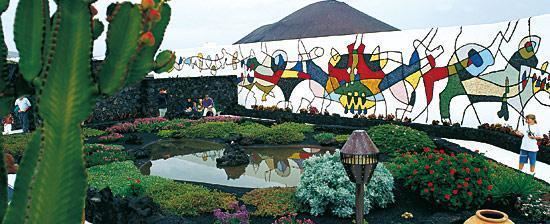Name Cesar Manrique Role Artist | ||
 | ||
Died September 25, 1992, Tahiche, Spain Artwork Teufelsfisch, Trapo, Kanfania | ||
[4K] LANZAROTE - WALK AROUND ARTIST MANRIQUE LAVA HOUSE
César Manrique ([ˈθesar manˈrike]) (24 April 1919 - 25 September 1992) was an artist and an architect.
Contents
- 4K LANZAROTE WALK AROUND ARTIST MANRIQUE LAVA HOUSE
- C sar manrique lanzarote
- Biography
- Csar Manrique Foundation
- Honours
- Works
- References
C sar manrique lanzarote
Biography

Manrique was born in Arrecife, Lanzarote. He fought in the Spanish Civil War as a volunteer in the artillery unit on Franco's side. He attended the University of La Laguna to study architecture, but after two years he quit his studies. He moved to Madrid in 1945 and received a scholarship for the Art School of San Fernando, where he graduated as a teacher of art and painting. Between 1964 and 1966 he lived in New York City, where a grant from Nelson Rockefeller allowed him to rent his own studio. He painted many works here, which were exhibited in the prestigious "Catherine Viviano" gallery.

Manrique had a major influence on the planning regulations in Lanzarote, when he recognised its tourist potential and lobbied successfully to encourage sympathetic development of tourism. One aspect of this is the lack of high rise hotels on the island. Those that are there are in keeping with the use of traditional colours in their exterior decoration.

Manrique died in a car accident at Tahíche, Teguise, very near the Fundación, his Lanzarote home, in 1992. He was aged 73.
César Manrique Foundation
The César Manrique foundation was set up in 1982 by César Manrique and a group of friends but wasn't officially opened until 1992 after Manrique died. The foundation, based at Manrique's home before he moved out for a quieter life, is a private, non-profit organisation set-up to allow tourists access to Manrique's home. The foundation is also an art-gallery featuring art created by Manrique himself as well as that acquired during his life. The gallery includes original sketches by Pablo Picasso and Joan Miró. The money the foundation takes from ticket sales goes toward raising awareness about the art of Lanzarote, as well as being used to fund the foundation's "artistic, cultural and environmental activities".

Manrique's home itself is built within a 3,000 m2 lot, on the site of the Lanzarote eruptions in the 18th century, and was created upon Manrique's return from New York City in 1966. The rooms on the first floor, including the artist studios, were created with the intention of keeping with Lanzarote traditions, yet making them more modern with open spaces and large windows. The "ground floor", more appropriately titled the "basement", contains five areas situated within volcanic bubbles, the rooms bored into volcanic basalt. There is a central cave which houses a recreational area, including a swimming pool, a barbecue and a small dance floor.

Once outside the main house, the visitor comes to the outside area, where there is a small square with a fountain in the middle before approaching a small café area and the visitor shop. This area was once César Manrique's garage.
One of the foundation's fundamental missions is to oppose the spread of high-rise concrete across the Spanish coastline and her island. The foundation recently brought attention to 24 illegally erected hotels in Lanzarote. This is a famous art gallery in the Island of Lanzarote
Honours
Works
In Lanzarote:
Outside Lanzarote:
